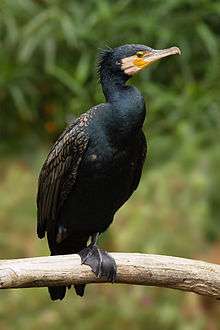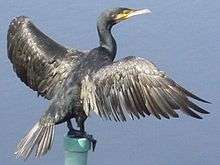Great cormorant
| Great cormorant | |
|---|---|
 | |
| In Victoria, Australia. | |
| Scientific classification | |
| Kingdom: | Animalia |
| Phylum: | Chordata |
| Class: | Aves |
| Order: | Suliformes |
| Family: | Phalacrocoracidae |
| Genus: | Phalacrocorax |
| Species: | P. carbo |
| Binomial name | |
| Phalacrocorax carbo (Linnaeus, 1758) | |
 | |
| Global range Year-Round Range Summer Range Winter Range | |

The great cormorant (Phalacrocorax carbo), known as the great black cormorant across the Northern Hemisphere, the black cormorant in Australia, the large cormorant in India and the black shag further south in New Zealand, is a widespread member of the cormorant family of seabirds.[2] The genus name is Latinised Ancient Greek, from φαλακρός (phalakros, "bald") and κόραξ (korax, "raven"), and carbo is Latin for "charcoal".[3]
It breeds in much of the Old World and the Atlantic coast of North America.
Description
The great cormorant is a large black bird, but there is a wide variation in size in the species wide range. Weight is reported to vary from 1.5 kg (3.3 lb)[4] to 5.3 kg (12 lb).[5] Males are typically larger and heavier than females, with the nominate race (P. c. carbo) averaging about 10% larger in linear measurements than the smallest race in Europe (P. c. sinensis).[6] The lightest average weights cited are in Germany (P. c. sinensis), where 36 males averaged 2.28 kg (5.0 lb) and 17 females averaged 1.94 kg (4.3 lb).[7] The highest come from Prince Edward Island in Canada (P. c. carbo), where 11 males averaged 3.68 kg (8.1 lb) and 11 females averaged 2.94 kg (6.5 lb).[8][9] Length can vary from 70 to 102 cm (28 to 40 in) and wingspan from 121 to 160 cm (48 to 63 in).[9][10] They are tied as the second largest extant species of cormorant after the flightless cormorant, with the Japanese cormorant averaging at a similar size. In bulk if not in linear dimensions, the Blue-eyed shag species complex of the Southern Oceans are scarcely smaller at average.[7] It has a longish tail and yellow throat-patch. Adults have white patches on the thighs and on the throat in the breeding season. In European waters it can be distinguished from the common shag by its larger size, heavier build, thicker bill, lack of a crest and plumage without any green tinge. In eastern North America, it is similarly larger and bulkier than double-crested cormorant, and the latter species has more yellow on the throat and bill and lack the white thigh patches frequently seen on great cormorants. Great cormorants are mostly silent, but they make various guttural noises at their breeding colonies.

Variations
A very rare variation of the great cormorant is caused by albinism. The Phalacrocorax carbo albino suffers from loss of eyesight and/or hearing, thus it rarely manages to survive in the wild.
Distribution
This is a very common and widespread bird species. It feeds on the sea, in estuaries, and on freshwater lakes and rivers. Northern birds migrate south and winter along any coast that is well-supplied with fish.
The type subspecies, P. c. carbo, is found mainly in Atlantic waters and nearby inland areas: on western European coasts and south to North Africa, the Faroe Islands, Iceland and Greenland; and on the eastern seaboard of North America, though in America it breeds only in the north of its range, in the Canadian maritime provinces.
The subspecies found in Australasian waters, P. c. novaehollandiae, has a crest. In New Zealand, it is known as the black shag or by its Māori name; kawau.[11] The syntype is in the collection of the Museum of New Zealand Te Papa Tongarewa.[12]
The 80–100 cm (31–39 in) long white-breasted cormorant P. c. lucidus found in sub-Saharan Africa, has a white neck and breast. It is often treated as a full species, Phalacrocorax lucidus (e.g. Sibley & Monroe 1990, Sinclair, Hockey & Tarboton 2002).
In addition to the Australasian and African forms, Phalacrocorax carbo novaehollandiae and P. c. lucidus mentioned above, other geographically distinct subspecies are recognised, including P. c. sinensis (western Europe to east Asia), P. c. maroccanus (north-western Africa), and P. c. hanedae (Japan).
Some authors treat all these as allospecies of a P. carbo superspecies group.
Behaviour

The great cormorant breeds mainly on coasts, nesting on cliffs or in trees (which are eventually killed by the droppings), but also increasingly inland. Three or four eggs are laid in a nest of seaweed or twigs.
The great cormorant can dive to considerable depths, but often feeds in shallow water. It frequently brings prey to the surface. A wide variety of fish are taken: cormorants are often noticed eating eels, but this may reflect the considerable time taken to subdue an eel and position it for swallowing, rather than any dominance of eels in the diet. In British waters, dive times of 20–30 seconds are common, with a recovery time on the surface around a third of the dive time.
Relationships with humans
Many fishermen see in the great cormorant a competitor for fish. Because of this, it was hunted nearly to extinction in the past. Thanks to conservation efforts, its numbers increased. At the moment, there are about 1.2 million birds in Europe (based on winter counts; late summer counts would show higher numbers).[13] Increasing populations have once again brought the cormorant into conflict with fisheries.[14][15] For example, in Britain, where inland breeding was once uncommon, there are now increasing numbers of birds breeding inland, and many inland fish farms and fisheries now claim to be suffering high losses due to these birds. In the UK each year, some licences are issued to cull specified numbers of cormorants in order to help reduce predation; it is, however, still illegal to kill a bird without such a licence.

Cormorant fishing is practised in China, Japan, and elsewhere around the globe. In it, fishermen tie a line around the throats of cormorants, tight enough to prevent swallowing, and deploy them from small boats. The cormorants catch fish without being able to fully swallow them, and the fishermen are able to retrieve the fish simply by forcing open the cormorants' mouths, apparently engaging the regurgitation reflex.
In Norway, cormorant is a traditional game bird. Each year c. 10,000 cormorants are shot to be eaten.[16] In North Norway, cormorants are traditionally seen as semi-sacred. It is regarded as good luck to have cormorants gather near your village or settlement. An old legend states that people who die far out at sea, their bodies never recovered, spend eternity on the island Utrøst – which can only occasionally be found by mortals. The inhabitants of Utrøst can only visit their homes in the shape of cormorants.
_immature.jpg) immature, Kazinga Channel, Uganda
immature, Kazinga Channel, Uganda Cranium
Cranium Drying after fishing
Drying after fishing_in_flight.jpg) Above Farmoor Reservoir, Oxfordshire
Above Farmoor Reservoir, Oxfordshire Colony in Juodkrantė, Lithuania, and damage to the trees in which they are nesting
Colony in Juodkrantė, Lithuania, and damage to the trees in which they are nesting Drawing by Jos Zwarts
Drawing by Jos Zwarts Kormorane in lake Vistonis, Greece
Kormorane in lake Vistonis, Greece
Videos
 Resting on a post in a port in Den Oever, the Netherlands
Resting on a post in a port in Den Oever, the Netherlands Stretching wings while sitting on a pole
Stretching wings while sitting on a pole Great cormorant hunting in Odessa
Great cormorant hunting in Odessa
References
- ↑ BirdLife International (2012). "Phalacrocorax carbo". IUCN Red List of Threatened Species. Version 2013.2. International Union for Conservation of Nature. Retrieved 26 November 2013.
- ↑ Ali, S. (1993). The Book of Indian Birds. Bombay: Bombay Natural History Society. ISBN 978-0-19-563731-1.
- ↑ Jobling, James A (2010). The Helm Dictionary of Scientific Bird Names. London: Christopher Helm. pp. 90, 301. ISBN 978-1-4081-2501-4.
- ↑ Ribak, Gal; Weihs, Daniel; Arad, Zeev (2005). "Water retention in the plumage of diving great cormorants Phalacrocorax carbo sinensis". Journal of Avian Biology. 36 (2): 89. doi:10.1111/j.0908-8857.2005.03499.x.
- ↑ "Cormorant". The Canadian Encyclopedia. Retrieved 21 August 2012. External link in
|website=(help) - ↑ Koffijberg, K.; Van Eerden, M.R. (1995). "Sexual dimorphism in the cormorant Phalacrocorax carbo sinensis: possible implications for differences in structural size" (PDF). Ardea. 83: 37–46.
- 1 2 Dunning Jr., John B., ed. (1992). CRC Handbook of Avian Body Masses. CRC Press. ISBN 978-0-8493-4258-5.
- ↑ Hogan, G. (1979). Breeding parameters of Great Cormorants (Phalacrocorax carbo) at mixed species colonies on Prince Edward Island, Canada (Master's Thesis). St. Catharines, ON: Brock University.
- 1 2 Hatch, Jeremy J.; Brown, Kevin M.; Hogan, Geoffrey G.; Morris, Ralph D. (2000). Poole, A., ed. "Great Cormorant (Phalacrocorax carbo)". The Birds of North America Online. Ithaca: Cornell Lab of Ornithology. doi:10.2173/bna.553.
- ↑ Stevenson, Terry; Fanshawe, John (2001). Field Guide to the Birds of East Africa: Kenya, Tanzania, Uganda, Rwanda, Burundi. Elsevier Science. ISBN 978-0-85661-079-0.
- ↑ Heather, Barrie; Robertson, Hugh (2005). The Field guide to the Birds of New Zealand (revised ed.). Viking. ISBN 978-0143020400.
- ↑ "Phalacrocorax carbo novaehollandiae; syntype". Collections Online. Museum of New Zealand Te Papa Tongarewa. Retrieved 18 July 2010.
- ↑ "Cormorants in the western Palearctic, Distribution and numbers on a wider European scale" (PDF). Wetland International Cormorant Research Group. Archived from the original (PDF) on 7 June 2011.
- ↑ "Workshop on a European Cormorant management Plan, 20–21 November 2007" (PDF). EIFAC, European Inland Fisheries Advisory Commission.
- ↑ "European Parliament resolution". 4 December 2008.
on the adoption of a European Cormorant Management Plan to minimise the increasing impact of cormorants on fish stocks, fishing and aquaculture
- ↑ "Reducing the conflict between Cormorants and fisheries on a pan-European scale" (PDF). Final Report. REDCAFE. p. 12.
Around 10,000 adult Cormorants (of the ‘Atlantic’ carbo race) are hunted legally as game in Norway outside the breeding season.
Further reading
- Sibley, C.G.; Monroe, B.L. (1990). Distribution and taxonomy of birds of the world. New Haven CT: Yale University Press.
- Sinclair, Ian; Hockey, Phil; Tarboton, Warwick (2002). SASOL Birds of Southern Africa. Struik. ISBN 1-86872-721-1.
- Separation of carbo and sinensis
- Newson, Stuart; Ekins, Graham; Hughes, Baz; Russell, Ian; Sellers, Robin (2005). "Separation of North Atlantic and Continental Cormorants". Birding World. 18 (3): 107–111.
- MIllington, Richard (2005). "Identification of North Atlantic and Continental Cormorants". Birding World. 18 (3): 112–123.
- Murray, T and Cabot, D. (2015). The Breeding Status of Great Cormorant (Phalacrocorax carbo carbo) in Co. Wexford. Ir. Nat. J. 34: 89-94.
External links
| Wikimedia Commons has media related to Phalacrocorax carbo. |
| Wikispecies has information related to: Phalacrocorax carbo |
- Ageing and sexing (PDF) by Javier Blasco-Zumeta & Gerd-Michael Heinze
- Great cormorant Species text in The Atlas of Southern African Birds
- BirdLife species factsheet for Phalacrocorax carbo
- "Phalacrocorax carbo". Avibase.

- "Great cormorant media". Internet Bird Collection.
- Great cormorant photo gallery at VIREO (Drexel University)
- Interactive range map of Phalacrocorax carbo at IUCN Red List maps
- Audio recordings of Great cormorant on Xeno-canto.
